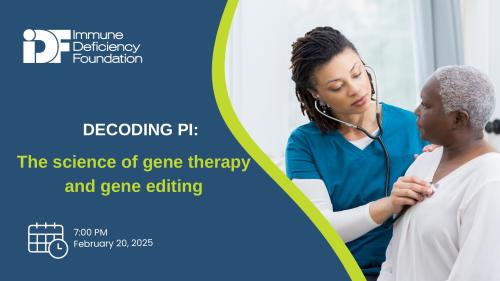
-
Understanding primary immunodeficiency (PI)

Understanding PI
The more you understand about primary immunodeficiency (PI), the better you can live with the disease or support others in your life with PI. Learn more about PI, including the various diagnoses and treatment options.
-
Living with PI
-
Addressing mental health
-
Explaining your diagnosis
- General care
- Get support
- For parents and guardians
-
Managing workplace issues
- Navigating insurance
-
Traveling safely

Living with PI
Living with primary immunodeficiency (PI) can be challenging, but you’re not alone—many people with PI lead full and active lives. With the right support and resources, you can, too.
-
Addressing mental health
-
Get involved

Get involved
Be a hero for those with PI. Change lives by promoting primary immunodeficiency (PI) awareness and taking action in your community through advocacy, donating, volunteering, or fundraising.
-
Advancing research and clinical care
-
Grants
-
IDF surveys
-
Participating in clinical trials
-
Diagnosing PI
-
Consulting immunologist
-
Clinician education

Advancing research and clinical care
Whether you’re a clinician, researcher, or an individual with primary immunodeficiency (PI), IDF has resources to help you advance the field. Get details on surveys, grants, and clinical trials.
-
Grants
The U.S. Department of Health and Human Services (HHS) added severe combined immunodeficiency (SCID), a PI that is typically fatal unless treated in infancy, to the Recommended Uniform Screening Panel (RUSP) in 2010, but it took eight years before all states implemented newborn screening (NBS) for the condition.
What accounted for the seemingly lengthy implementation period? A recently published paper by the Association of Public Health Laboratories (APHL) explores that question for SCID and six other congenital conditions added to the RUSP from 2010 to 2022. APHL is a federally funded membership organization representing U.S. laboratories that monitors the implementation of newborn screening for core conditions on the RUSP.
“The conditions added since 2010 have introduced new challenges for newborn screening,” particularly in the areas of laboratory testing, confirmatory and diagnostic testing, and long-term follow-up, according to the paper.
SCID is screened by extracting DNA from dried blood spots taken from a baby and analyzing the DNA through a laboratory technique called polymerase chain reaction (PCR). This molecular test measures the number of T-cell receptor excision circles (TRECs) in the blood and can reveal if a child is making T cells. The hallmark of SCID is a lack of T cells in a baby. (A bone marrow transplant (BMT) which provides a functioning immune system to the baby, is the standard treatment.)
SCID was the first condition added to the NBS RUSP that required this type of molecular technology, and laboratories had to adapt to perform the PCR test. Some states expanded their laboratory capabilities, while others sent their samples out to contracted laboratories.
“One of the reasons that SCID newborn screening took longer to implement was the need for programs to add capacity for molecular testing,” according to the paper.
Molecular testing required resources to develop and calibrate the test, create an implementation plan, purchase additional equipment, and hire and train staff on the new technology.
However, the implementation of molecular testing for SCID paved the way for PCR-based testing for four of the subsequent conditions added to the RUSP after SCID, including spinal muscular atrophy (SMA), which was multiplexed with SCID.
Other common barriers experienced across the implementation of all seven conditions included consensus on the targets of screening, budgeting processes, validating testing, developing follow-up plans, and creating educational materials.
The following is a list of all conditions added to the RUSP since 2010, detailing the year they were added and the number of states and territories (a total of 53) that have included the conditions in their screening programs as of December 2022:
- SCID (2010)—53 programs with full implementation spanning 8.6 years
- Critical congenital heart disease (CCHD) (2011)—53 programs with full implementation spanning 6.8 years
- Glycogen storage disease, type II (Pompe) (2015)—37 programs
- Mucopolysachharidosis, type I (MPS I) (2022)—34 programs
- X-linked adrenoleukodystrophy (X-ALD) (2016)—32 programs
- SMA (2018)—48 programs
- Mucopolysachharidosis, type II (MPS II) (2022)—2 programs
“Experiences with the implementation of screening for conditions added to the RUSP since 2010 reflect the heterogeneity of conditions that can be identified through expanded newborn screening,” wrote the authors of the paper.
“In addition, the recent additions have introduced additional testing platform types and reflexed or tiered testing and have entailed new challenges in follow-up, education, outreach, and clinical complexity. Despite those challenges, most NBS programs have been able to implement new screening recommendations within several years.”
There are currently 35 core conditions on the RUSP, and it takes an average of 5 to 6 years for states to start screening for a new condition added to the RUSP. To expedite the implementation, some states have adopted RUSP alignment legislation that requires new RUSP conditions to be instituted within a certain timeframe.
Diagnosis
Related resources
Sign up for updates from IDF
Receive news and helpful resources to your cell phone or inbox. You can change or cancel your subscription at any time.





The Immune Deficiency Foundation improves the diagnosis, treatment, and quality of life for every person affected by primary immunodeficiency.
We foster a community that is connected, engaged, and empowered through advocacy, education, and research.
Combined Charity Campaign | CFC# 66309



